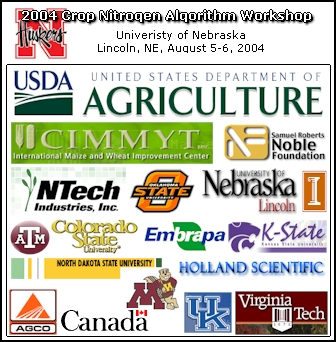
GPS Capture Program (follow this link)
Regional Trial Protocol, 2006
Questions Concerning the Regional Trial Can be Addressed To:
Newell R. Kitchen
ARS-USDA Cropping Systems and Water Quality Research Unit
University of Missouri
Columbia, MO 573 882-1135
kitchenn@missouri.edu
Robert Mullen
Extension Specialist/Assistant Professor
OARDC - School of Natural Resources
1680 Madison Ave.
Wooster, OH 44691
330 263-3785
Bill Raun
Oklahoma State University
Stillwater, OK 74078
405 744-6418,
wrr@mail.pss.okstate.edu
Data to be Collected at ALL Sites, and from all Plots
NDVI, V6, V8, V10, V12
SPAD, V6, V8, V10, V12
Daily Temperature (min and max), entire season
Precipitation, entire season
Issues for ALL TRIALS
Replications: 3-4
Plot size: 4 rows wide x 20 - 30 ft long
Row Spacing: As per equipment used (30" or 36")
P and K applied preplant to local
sufficiency levels
Nitrogen to be applied between V8 and V12
Nitrogen Sources:
1. Pre-Plant: Urea or UAN
2. Topdress: UAN
Sensor/Chlorophyll Meter Readings
Active Sensor readings taken weekly, Greenseeker RED
Chlorophyll meter readings (SPAD) taken weekly
Pre Plant Soil Tests (0-12, and 12-24")
NO3-N, and NH4-N
Total N
Organic C
pH
|
Treatment |
Pre-plant N |
Top-dress |
Comments |
|
|
lb/ac |
lb/ac |
|
|
1 |
0 |
0 |
Check |
|
2 |
N Rich Strip |
0 |
N Rich Strip (160 to 200 depending on preplant soil test) |
|
3 |
40 |
0 |
|
|
4 |
40 |
30 |
|
|
5 |
40 |
60 |
|
|
6 |
40 |
90 |
|
|
7 |
40 |
120 |
|
|
8 |
40 |
150 |
|
| 9 | 40 | 180 | |
|
10 |
40 |
|
Sufficiency (30lbs applied when SI<95%) |
At the end of the season, algorithms will be evaluated to determine which ones predicted the optimum N rate, and the deviation from the optimum rate.
A. At the time topdress N is applied (between V8 and V10), each collaborating entity (e.g., OSU, UNL, USDA-ARS-Missouri, etc.) will have the opportunity to submit the N rate they deem to be the optimum (using either the NDVI, Chlorophyll, or soil test data). Predicted N rates from each institution will be posted on the web site. Actual rates to be applied by each collaborating institution will not be necessary using the treatment structure above, since a response curve will be determined at each site, that will establish apriori the optimum N rates (both max yield and economic).
B. Once grain yield data has been compiled, data will be forwarded to Robert Mullen who has agreed to tabulate the entire data base for combined analysis. However, everyone who wants access to the raw data can do so.
C. It is imperative that all data be collected at each site (noted above) so that this group can establish what algorithms are working where, and why.
--------------------------------------------------------------------------------------------------------------------
Method of Application:
1. Nitrogen Sufficiency-USDA-ARS, UNL
a. Minolta SPAD meter readings collected
from treatment 2 (t2) and treatments 7 (t7) and 8 (t8)
b. 30 lbs N/ac applied to treatments 7 and/or 8 whenever whenever t7/t2 or
t8/t2 SPAD meter readings result in a value <0.95
c. N should be applied in a continuous stream using 50-200 ml syringes
(all 4 rows treated the same)
d. Treatments 2, 7, and 8 monitored throughout the cycle and N applied (30
lb N/ac) whenever the sufficiency (t7/t2 and/or t8/t2) was less than 0.95.
2. NFOA
a. NDVI sensor readings (and CV) collected from treatments 2 (t2),
treatment 9 (t9) and treatment 10 (t10) between the V8 and V10 growth
stages. Readings should be collected from the center 2 rows, the
entire length of the plot.
b. Using the Sensor Based Nitrogen Rate Calculator that is available on
the web, use either the "Corn Rainfed" or "Corn-Irrigated" algorithm
depending on your growing conditions.
http://www.soiltesting.okstate.edu/SBNRC/SBNRC.php
c. Enter the number of days from planting to the day of sensing
d. Enter NDVI values for treatment 9 in the "Farmer Practice"
e. Enter NDVI values for treatment 2 in the "N Rich Strip"
f. Enter CV value (for each plot) for treatment 9 and 10 in the "Coefficient of Variation
(CV)" (this
will be the average CV value displayed on the Hand-Held GreenSeeker once
complete sensing the center 2 rows)
g. Enter a Maximum Yield for the Region (generally 2 times the average
yield for a field, usually not less than 300 bu/ac)
h. Enter the Plant Population in either plants/ac or plants/ha
depending on what units you are using. Preferably this should be the
plant population at sensing, but you can use "planted" population even
though it will be a bit higher.
i. Click "Submit" to obtain N Rate Recommendation (available in English or
Metric Units by clicking appropriate buttons below)
j. Repeat steps c-i substituting treatment 10 for treatment 9.
k. N should be applied at the base in a continuous stream using 50-200 ml
syringes (all 4 rows treated the same)
Comments: note the Response Index will be different for treatment 9 and 10, because the N Rich Strip is divided by the NDVI value in these respective treatments. In general, you should expect less topdress N to be applied topdress in treatment 10 versus treatment 9. Details on how the N rate is calculated (step h) are available at http://www.nue.okstate.edu/RI_CV_Discussion.htm
An excel file that can be used in the field with your PDA (does everything the SBNRC does) .... follow this link (EXCEL file)
3. Missouri
Instructions for VR N Using Active-Light Sensors: Missouri 2004 version
For this algorithm, you’ll be using the ratio of the visible to NIR (i.e., VIS/NIR).
IN each case where VIS/NIR is included below, this is the simple ratio (last output value on the GreenSeeker sensor). SR = (VIS/NIR)
Collect sensor reflectance readings on treatments 2, 11, and 12 (t2, t11, and t12) sometime between V8 and V10 (preferably closer to V10) at approximately 53 cm above the height of the corn canopy.
Treatments t11 and t12 are designated as the “target”, and treatment t2 is designated as the “reference.”
Calculate the N rate for t11 and t12 as follows: N rate (lbs/acre) = -200 + 250 x [ VIS/NIR(target) / VIS/NIR(reference). Using this equation, corn that looks exactly like the reference will still receive 50 lbs N/acre.
Apply N as close in time to when senor readings are taken as possible.
N source and placement methods should follow the same procedure as the listed for the other treatments being tested
4. Virginia
Follow guidelines in the on-line spreadsheet.
----------------------------------------------------------------------------------------------------

